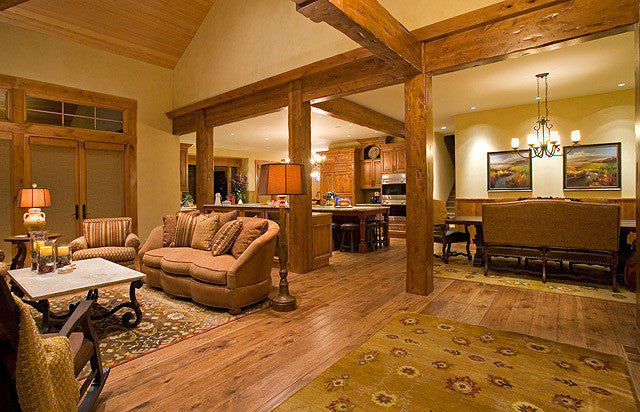What's a Hybrid Log Home?

For many who dream of owning a log home, a traditional stacked-log home may be too expensive. Fortunately, there are other options. Depending on your builder, you can also choose from post-and-beam, timber-frame, and hybrid log homes. Hybrid construction, in particular, is an alternative worth considering.
What Is a Hybrid Log Home?
As its name suggests, a hybrid log home blends different types of construction into a new style. A hybrid design incorporates rounded logs or squared timber sparingly to enhance the interior design. Typically the outside of the home will resemble regular stick-built houses, with a few logs visible inside to give it a cabin feel. You might see log beams and posts framing the entryway or on display in the living room. A hybrid home may even use precut beams to give the impression of full logs without adding weight and cost. Rather than being integral to the home's structure and support, these beams are largely ornamental, added to ceiling or walls for visual effect.
How Do Hybrid Log Homes Differ From Traditional Log Homes?
Hybrid homes differ from traditional homes in a few ways. First, although the walls of stacked-log homes consist entirely of logs, the walls of hybrid homes are framed like regular homes. Hybrid homes typically take less time and money to build, because they avoid some of the inconveniences inherent in stacked-log construction.
For instance, you aren't left with a lot of chinking, staining, or sealing to do, and installing plumbing and wiring will be easier. Nor do hybrid homes settle as do stacked-log homes, which require attention and adjustments from the owner as logs shrink over the first few years. Log home repair is also much simpler for hybrid homes, because most problems won't require you to replace log sections.
What Are the Pros and Cons of Building or Owning a Hybrid Log Home?
When it comes to building, one of the biggest advantages of hybrid construction is its inherent flexibility. You can design a home with as many or as few logs as you want, which in turn gives you more control over your budget. Depending on the climate where you plan to build, a hybrid home with its wall studs and insulation may also be a more practical choice in terms of energy efficiency.
Log home maintenance will be easier with a hybrid home, too. You can use traditional siding in some places and strategically placed full beams in a few visible or prominent areas. This will reduce the amount of chinking, wood stain, and sealers you need to buy. You also don't need to deal with settling and shrinking and the maintenance tasks associated with them. In the end, as long as a hybrid home suits your style, there is no real downside. You will certainly save some time and money by going with a hybrid design, and you will find the logistics and maintenance to be less hassle. Unless you have your heart set on an absolutely authentic log cabin, a hybrid log home gives you the best bang for your buck and more ways to express your individuality.
Image via Flickr by stevebennettbuilders




